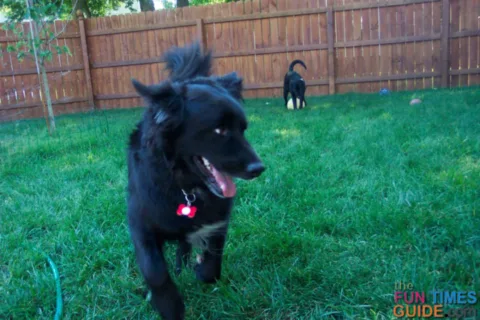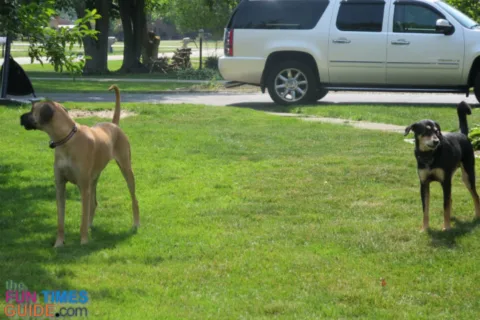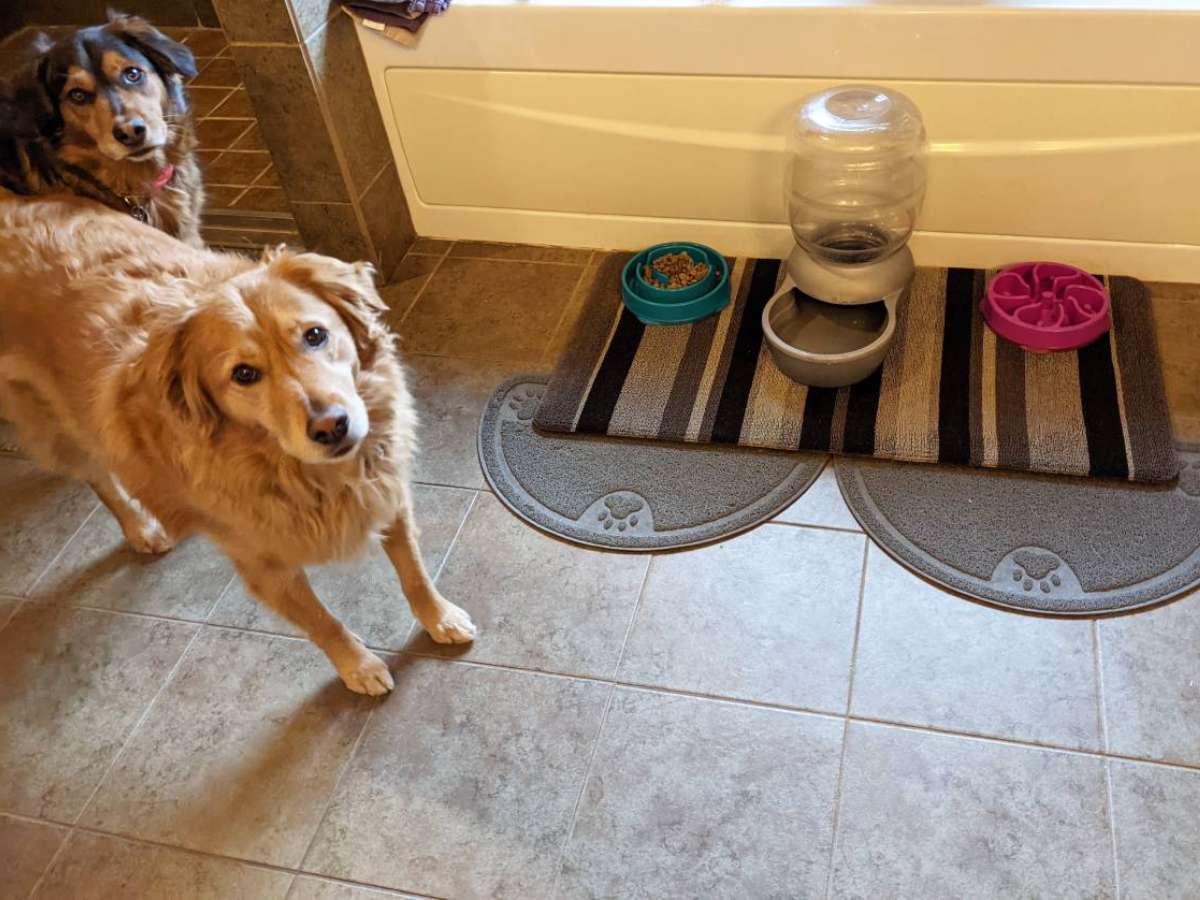Jim and I are considering installing an invisible dog fence at our new home (location yet to be determined), so I’ve been researching the many options when it comes to invisible fences.
I’ve always wondered exactly how (and how well!) invisible fences work at keeping dogs safe within your yard.
For the record, we have two Black Lab-mixes (ages 3 and 1) and we’ve used a 6-foot privacy fence up to now. I love it because it allows us let the dogs to play in the backyard, unattended. However, we are likely going to move to a place on the lake, so wouldn’t want to obstruct any views (ours, or our neighbors’). For that reason, an invisible fence seems like the way to go.
We’ve heard great things from dog owners who are currently using an invisible fence system, specifically, the owner of a Chocolate Lab, the owner of a Jack Russell Terrier, and the owner of a Great Dane.
Here are some things I’ve learned about invisible fences, in general (NOT specific to the “Invisible Fence” company itself)…
How Much Invisible Fences Cost
- Invisible fences require less upkeep & maintenance than traditional fencing. They are quicker and easier to install, as well.
- To give you an idea of pricing, it cost us approximately $1,700 to have a 6-foot privacy fence professionally installed around our 1/4-acre backyard (with 2 wide fence gates). It would cost about $800-$900 to have a hidden fence professionally installed in the same area, or about $200-$300 to do it yourself.
An electronic fence for a 1/4-acre lot, or approximately 600 linear feet of wire, with a second electronic boundary within the yard say, near a garden bed, costs about $905. You can buy a kit for about $300 and save 67% by installing it yourself.
~ Source
You have to replace the battery in the dog collar every 3-4 months, depending on how often your dog “tests” the hidden fence. Otherwise, your dog could freely escape the boundaries. It is said that dogs can tell when the battery is getting low — at which point they may try to take advantage of the situation. Thus, it’s important to include the cost of replacement batteries (anywhere from $60-$90 a year) when budgeting for your invisible fence system.
Here are some money-saving tips for replacing fence collar batteries.
Why Hidden Fences Are Good
- Invisible fences can be used with puppies 8 weeks of age and older — so long as they know basic commands (sit, stay, come). Toy breed dogs must weigh at least 2-1/2 pounds in order to manage the weight of the correction collar.
- Typically, invisible fence systems will work in any size yard from 1/4 of an acre to more than 25 acres.
- An invisible fence can be placed practically anywhere… through hilly or rocky terrain, into wooded areas, and even underwater.
- Unlike traditional fences, invisible fences won’t prevent you and your neighbors from enjoying the surrounding landscape or water views.
- Hidden fences require much less upkeep. (Speaking from experience, I’m so tired of having to use the weed-wacker on both sides of our privacy fence each time we mow. And it’s a royal pain to have to keep re-painting it every year or two to keep it looking nice, too.)
- The “original” Invisible Fence brand itself is endorsed by the ASPCA (American Society for the Prevention of Cruelty to Animals), the OSPCA (Ontario Society for the Prevention of Cruelty to Animals), and numerous veterinarians.
The invisible fence system has been awarded by the Humane Society for its compassionate program because it first gives the dog an auditory warning, then there is a hesitation, and then the correction. The correction setting is very mild to start.
~ Source
Most invisible fence systems are guaranteed to work with your dog. Therefore, even if you think you have a head-strong dog who cannot be contained within an invisible fence system, it may be worth trying, so long as they guarantee it.
QUESTION: I have a very bright dog, will he be able to outsmart the system?
ANSWER: No, he will probably be trained much faster than other dogs.~ Source
How An Invisible Fence Works
- Dogs are typically trained to stay about 8 feet from the boundary wire. When they start to get closer to the boundary, you’ll know it’s time to change the battery in the fence collar.
- The strength of the electrical signal emitted by the wire can be adjusted (underground) by the invisible fence company. The stronger the signal, the farther away the dog must stay from the wire in order to avoid being corrected.
Underground fence is not a buried hot wire that zaps a dog for getting close to the boundary. It is a radio antenna that sends out a signal that activates a battery in the dog’s collar. The battery causes a shock similar to static electricity, and the dog backs off. The field of radio waves can be adjusted so that the dog does not get too close to the edge of the property before hearing the warning tone.
~ CanIsMajor.com
Installation A Hidden Dog Fence
- Before the invisible fence can be placed underground in your yard, power lines and underground pipes must be located and marked. As a result, you may have to postpone the installation of your invisible fence, based on how quickly the local utility company can come out and mark your property.
- The computerized controller unit for the invisible fence is typically installed in the garage or basement near an existing outlet. It takes up more wall space that I imagined, but most computerized units like this are highly reliable and prevent interference (and random shocks) from stray electrical fields.
- An “indoor” model of the invisible fence can be used inside your home (in lieu of baby gates) to keep pets out of certain rooms or off certain furniture. Typically it costs $120-$150 for the indoor unit. (Here’s how the hidden fencing works indoors.)
- If you live near water, invisible fence systems can be placed such that your dog will be completely blocked from entering the water OR the company can lay wire in the water to allow your dog some room to swim. However, if you live in an area where there are tides, access to the water will probably need to be blocked altogether.
- You can use invisible fencing to block a dog’s access to places within your yard as well, like around a swimming pool, a garden or a tree.
- Some people use an invisible fence around the perimeter of a “traditional” privacy fence in order to keep dogs that like to dig or are habitual escape artists from getting out of the yard.
If You Move Or Travel With Your Dog…
- You can usually take your invisible fence system with you if you move to a new location.
- If the previous owners of your new home left an invisible fence behind, you can have a company rep come out an check its effectiveness. Most likely, you’ll be able to use the existing invisible fencing as is — you’ll just need to purchase a collar for your dog.
- Some indoor hidden fence systems are portable, allowing you to take it with you when you travel.
Training Your Dog To Respect Hidden Fence Boundaries
- Most invisible fence companies will help you train your dog to get used to the boundaries. Over the course of about 2 weeks, one of their trainers will periodically visit your home and work with you and your dog. Of course, you will also be training your dog alone at times, all the while offering loads of praise any time your dog respects his new boundaries.
- You can still walk your dog outside the boundaries of your yard, so long as he does not have the invisible fence collar on at the time. (The collar should be removed every time you leave your yard to walk your dog or go for a ride in the car.)
There is a recommended procedure you go through each time to train your dog when it’s okay to leave the yard and when it’s not.
The Invisible Fence Dog Collar
- After months (or years) of using the invisible fence, some people take the collar off their dog permanently, though it’s not recommended. In reality, it depends on the personality and behavior of your dog.
- It is recommended that you remove the collar every night during the first month and at least once a week from then on. This prevents rashes and irritation from prolonged use.
- Some dogs with very thick coats need to have a small patch of fur around their necks trimmed on a regular basis in order for the collar correction to work.
- If you have more than one dog, you can get more than one collar for use with the same invisible fence. However, the dogs may feel the correction at different intensities — especially if one is large dog and the other small, or one has long hair and the other short.
Downsides To Invisible Fences
- If there is a power failure, your invisible fence becomes useless during that time. Therefore, if you live in an area that experiences frequent storms & power outages, you may want to reconsider installing an invisible fence.
- Under the right conditions, a panicked dog could run through the boundary, then be hesitant to come back through the barrier.
- An invisible fence may keep your dog IN the yard, but it doesn’t keep other dogs or wild animals OUT. So, there’s always a chance that your dog could be attacked or get in a fight with another dog or animal inside the boundaries of your invisible fence. (Such is why your dog should always be supervised even in a yard protected by an invisible fence.)
Some dogs have a high pain threshold and will go through the barrier if the distraction is strong enough. Once they go through, they receive the correction when trying to re-enter the yard and may be reluctant to return when the chase is done.
~ CanIsMajor.com
More About Dog Invisible Fences
- DIY: How To Make Your Own Invisible Fence Replacement Battery
- Some Things To Think About Before Installing An Invisible Fence
- Reasons NOT To Get An Invisible Dog Fence
- PetSafe Invisible Fences: In-Ground & Wireless Systems
- Money-Saving Tips For Replacing Invisible Fence Batteries In Your Dog’s Collar









